After Dinner Jupiter and a Morning Venus Trio, and I Suggest Some Spring Evening Galaxies While the Morning Moon is Wrestling Scorpius!
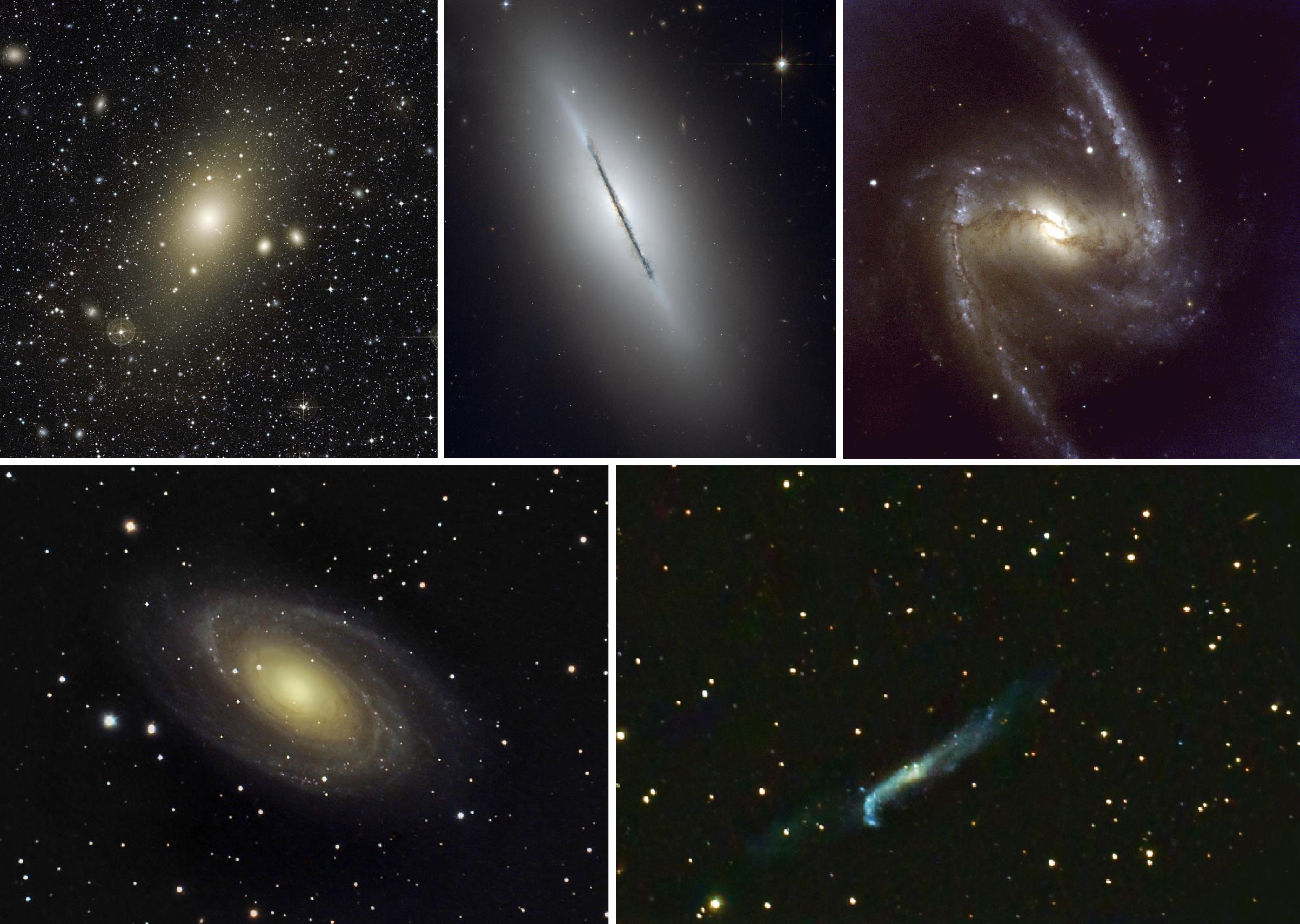
A sampling of galaxy forms. Clockwise from upper left: Messier 87 “Virgo A” (elliptical), Messier 102 “Spindle” (lenticular), NGC 1365 (barred spiral), NGC 4656 “the Crowbar” (irregular), and Messier 81 “Bode’s Nebula” (spiral). All except NGC 1365 are visible on spring evenings from mid-northern latitudes.
Hello, Mid-April Stargazers!
Here are your Astronomy Skylights for the week of April 13th, 2025 by Chris Vaughan. Feel free to pass this along to your friends and send me your comments, questions, and suggested topics. You can also follow me on FaceBook, Instagram, Threads, and Bluesky as astrogeoguy! Unless otherwise noted, all times are expressed in Eastern Time. To subscribe to these emails please click this MailChimp link.
If you’d like me to bring my Digital Starlab portable inflatable planetarium to your school or other daytime or evening event in Simcoe, Grey, and Bruce Counties, or deliver a virtual session anywhere, contact me through AstroGeo.ca, and we’ll tour the Universe, or the Earth’s interior, together! My book with John A. Read entitled 110 Things to See With a Telescope is a guide to viewing the deep sky objects in the Messier List – for both beginners and seasoned astronomers. DM me to order a signed copy!
The moon will finally clear out of the evening sky towards the end of this week, so I highlight where to find a treasure trove of spring galaxies, some tips for best viewing results, and how we classify galaxies astronomically. Meanwhile the morning moon will encounter the stars of the Scorpion, Jupiter and Mars will shine in evening, and Venus will gleam above three other planets in the east before sunrise. Read on for your Skylights!
The Moon
Last week here I described how the timing of Saturday’s full pink paschal mini moon scheduled Passover that is underway now and placed Easter on next Sunday. This week worldwide, the moon will be rising late at night and lingering into the morning daylight while it wanes in phase. Starting on Wednesday, Earth’s natural night-light will rise after midnight, so galaxy lovers can return to viewing those distant delights in evening. I’ll share more on that below.
Tonight (Sunday) the still very fully-illuminated moon will rise after dusk, all but obscuring the stars of Virgo (the Maiden) and Libra (the Scales) that surround it. On Monday night, the waning gibbous moon will straddle the Scales’ stars. The name of the golden star Zubenelhakrabi, which shines closer to Scorpius, means “Claws of the Scorpion”. Although the Babylonians had envisioned it, plus the bent line of bright stars Zubeneschamali, Zubenelgenubi, and Brachium to its upper left, as balance scales, the Greek and Arab astronomers envisaged them as the outstretched claws of a great scorpion. Sometime around the 2nd Century, the ancient Romans created the modern constellation of Libra by clipping off the claws of Scorpius, but their original names have been retained. The Arabic word zuben means “claw”. Zubenelgenubi, the highest of the scale stars, is a nice double star that is easily split in binoculars as well as a backyard telescope. The less brilliant, lower star Brachium is a reddish star.

When the moon clears the treetops to the east around midnight on Tuesday, it will be close to the row of several medium-bright stars that currently make up the claws of the Scorpius (the Scorpion). Astrologers use the name Scorpio for the same stars. From upper left to lower right, the modern-day stars are named Jabbah or Nu Scorpii, Graffias or Acrab, Dschubba, Fang or Pi Scorpii, and Iklil or Rho Scorpii. Graffias, Dschubba, and Fang are the brightest. Your eyes will also spot the up-down pair of stars named Jabhat Acrabi (or Omega Scorpii) below Acrab. A backyard telescope at high magnification will reveal that Nu Scorpii, Graffias, and Dschubba are all close-together double stars. Beyond midnight, Scorpius’ brightest star, the red giant Antares will appear below them. Antares is located just 4 degrees south of the ecliptic. That means that the moon, and even the occasional planet, can pass in front of (or occult) it. Antares’ name arises from an ancient Greek expression for “rival to Ares”, which we know better as the planet Mars.
As a bonus, anyone in most of North America can watch the moon approach and then cross in front of Pi Scorpii around 5 am EDT or 12:30 am PDT. Lunar occultations are safe to watch with eyes, binoculars, and telescopes. Use an app like Starry Night or Stellarium to look up the timings where you live. Be sure to start watching a few minutes ahead of time.

Overnight on Wednesday, the 84%-illuminated moon will shine to Antares’ lower left. By dawn on Thursday they’ll be side by side above the south-southwestern horizon.
The waning moon will spend Friday through next Sunday crossing the teapot-shaped stars of Sagittarius (the Archer). It’ll be inside the pot on Saturday morning. You’ll only see the moon between the wee hours and noon. Watch for its pale, football-shaped form hanging low in the southern sky while you walk the dog around breakfast time.
The Planets
Since you may have been up early for your moon fix, let’s start by touring the four planets that are rising in the east ahead of the sun nowadays. Only three of them are visible because remote Neptune is too faint to compete with the morning twilight.
The extremely bright planet Venus has become the “morning star” in the east every morning. Ancient skywatchers used to think Venus in evening and Venus in morning were two separate objects, hence the dual names. This week, Venus will be rising at around 5 am local time, or 90 minutes before the sun. You’ll be able to catch sight of it gleaming between the trees or buildings until almost sunrise. Venus is increasing its angle from the sun every morning. By the end of April, it will rise while the sky is still dark. In good binoculars or a telescope, Venus will currently show a slender, waxing crescent phase on a disk that is similar in size to Jupiter.

Meanwhile, the much fainter specks of Mercury and Saturn will shine side by side below Venus this week. Mercury, on the left, will be a little brighter than Saturn. If you have an unobstructed view of the eastern horizon and no clouds or haze, search for them with binoculars a palm’s width below Venus starting around 6 am local time. Be sure to turn binoculars away from the horizon before the sun starts to rise. Observers living closer to the tropics will see the three planets much more easily, since they’ll be higher and in a darker sky. Mercury and Saturn will be shifted more to Venus lower right, though.
With each passing day, Saturn, on a parallel track to Venus, will climb a little higher and slide farther to the right of Mercury. Mercury will climb a little, too, but remain to Venus’ lower left. Venus and Saturn will remain fixtures of the eastern sky for the next few months. Jupiter will join them in July.
The three other planets are in the western evening sky. Uranus is low in the sky after dusk and is not easy to see, but extremely bright, whitish Jupiter and medium-bright, reddish Mars are still worth a peek – for now.
Since the stars and planets in the western sky set four minutes earlier every day, we only have about another three or four weeks to see Jupiter reasonably well through telescopes. After mid-May, when it will be a bright dot swimming in the twilight sky above the western horizon after sunset, it will appear rather muddled through a telescope. After early June, Jupiter will be gone from sight while it prepares to pass the sun.
This week, bright Jupiter will become visible almost halfway from the horizon to the zenith once the western sky begins to darken after sunset. You’ll get nice views of the big planet through binoculars and telescopes until about 10:15 pm local time. It will set around 12:30 am local time. Taurus’ brightest star, reddish Aldebaran will be twinkling a fist’s diameter below Jupiter. Over the next month, Jupiter’s easterly prograde motion will carry it farther above Aldebaran. The winter constellations of Orion (the Hunter), Gemini (the Twins), and Auriga (the Charioteer) will surround the giant planet.
When viewed in any size of telescope, Jupiter will display a large disk striped with several dark brown belts and beige light zones, all aligned parallel to its equator, which is tilted whenever the planet is descending in the west. With a better grade of telescope, Jupiter’s Great Red Spot, a cyclonic storm that has raged for hundreds of years, will be visible for several hours when it crosses the planet every 2nd or 3rd night. For observers in the Eastern Time zone, the GRS will cross Jupiter’s disk during early evening tonight (Sunday), Friday, and next Sunday, and also around 11 pm on Tuesday, Friday, and next Sunday. If you have any coloured filters or nebula filters for your telescope, try enhancing the spot with them.
Any size of binoculars will show you Jupiter’s four Galilean moons named Io, Europa, Ganymede, and Callisto lined up beside the planet. Those moons complete orbits of the planet every 1.7, 3.6, 7.2, and 16.7 days, respectively. If you see fewer than four moons, then one or more of them is crossing in front of or behind Jupiter, or hiding in Jupiter’s dark shadow – or two of the moons are very close together, or one moon is eclipsing or occulting another one. For the Americas, all four moons will gather to one side of Jupiter on Monday and Thursday.

From time to time, observers with good quality telescopes can watch the black shadows of the Galilean moons travel across Jupiter’s disk. In the Americas, Ganymede’s large shadow will follow the great red spot across Jupiter on Wednesday evening, April 16 from dusk to 9:17 pm EDT (or 01:17 GMT on Thursday). Additional shadow crossings will be visible in other time zones.
Finally, once the sky becomes dark, you can look very high in the southwestern sky and find reddish Mars shining off to the lower left (or celestial southeast) of the two bright stars Pollux and Castor in Gemini (the Twins) – the trio nearly in alignment. On Saturday Mars’ easterly orbital motion carried it from Gemini into next-door Cancer (the Crab). The planet will move appreciably farther from Pollux and Castor over this week and brush against the large Beehive star cluster in early May. You can view Mars through a telescope until the wee hours of the night, but it’s very small nowadays.
Another Spring Galaxy Week
Back on March 23, I highlighted here a number of galaxies in Leo (the Lion) that you can track down and view in your backyard telescope. April brings yet another opportunity to enjoy galaxies while the moon is out of the evening sky for the next two weeks. It’s a thrill to glimpse a faint fuzzy patch and know that its light has been journeying for perhaps 60 million years before it passes through your telescope and lands on your retina!
Every spring in the Northern Hemisphere, the obscuring stars, gas and dust of our own Milky Way galaxy vacates the night sky overhead, leaving a literal window of opportunity for observers to see distant galaxies. The completely moonless evenings from April 16 to 29 will provide us with the dark skies we need for seeing these faint, but spectacular objects. If you don’t have clear skies this time, you’ll be able to try again from May 18 to 28.
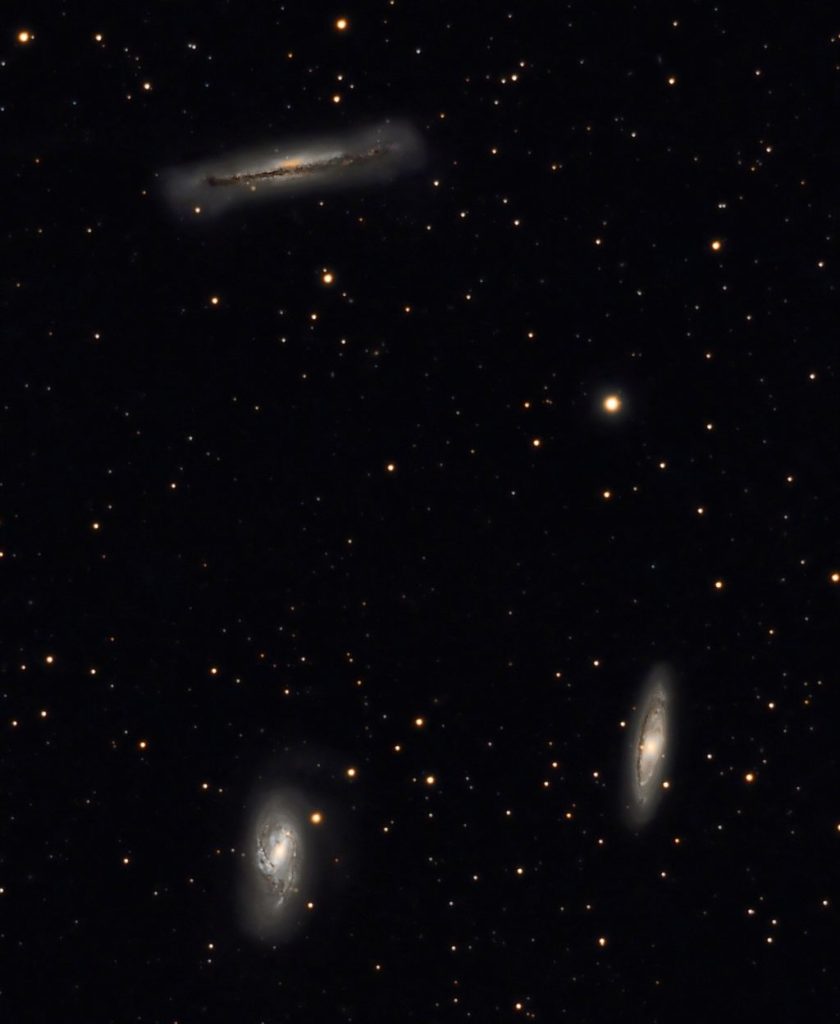
Galaxies show most easily, and display the most detailed structure, when the night sky is dark and transparent. That means cloudless, moonless, free from artificial lights, and relatively clean and dry. (Moisture and/or dust in the air dims objects.) Moonlight aside, the sky is as dark as it can be when the sun is more than 18 degrees below the horizon. At mid-northern latitudes this week, that deep darkness will begin when evening astronomical twilight ends around 9:45 pm local time.
On a clear, moonless evening, find a safe location away from urban lights, and look southeast. About halfway up the sky, to the upper right of the very bright star Arcturus, you’ll find the faint stars of the constellation of Coma Berenices, or “Bernice’s Hair.” Coma, for short, contains the north galactic pole where there are far fewer stars and galactic dust and gas than in the rest of the sky. That part of the sky climbs high overhead towards midnight during April, and during mid-evening in May. Both of those windows are perfect for viewing distant galaxies through the least amount of Earth’s distorting atmosphere, but you can start looking anytime after 9:45 pm this week. Coma Berenices and the constellations around it – Virgo (the Maiden), Leo (the Lion), Ursa Major (The Big Bear, and the Big Dipper’s home) and Canes Venatici (the Hunting Dogs) – all host a great many galaxies. I’ll post a sky chart here that shows where many of the brightest ones are.
Galaxy-viewing is easier with a good quality telescope featuring a 4” or 102 mm aperture, or larger, and a dark location that is free of light pollution. Set up your telescope with the lowest power eyepiece (or lens) in it. That’s the one with the largest number printed on it. That long focal length eyepiece will show the largest possible patch of sky through a telescope – making finding galaxies easier. (You can also see many of the following targets in larger binoculars from dark, rural sites.)
Now aim your telescope at the medium-bright star named Denebola, which marks the tail of Leo (the Lion), and focus it until Denebola is a pinpoint. Next, without changing the focus, aim at the spot exactly midway between Denebola and the medium-bright star Vindemiatrix in Virgo (the Maiden), which sits nearly two outstretched fist diameters to the lower left (or 17 degrees to the celestial east) of Denebola. You actually don’t need to be overly precise here because there are galaxies all over the place.

If your sky is dark and your eyes are dark-adapted (I’ll share more about that below), you should see a number of dim, fuzzy patches in the eyepiece. Those are members of the Virgo Cluster of Galaxies – some larger, some smaller. If you can’t be sure you’re seeing them, try lightly tapping telescope tube while you are looking. The smudges will jump around a little, allowing your brain’s wiring to see them better. Nudge the telescope around to see how many you can find. (There are dozens in that patch of sky). If you mess up the focus, or get lost, just start over on Denebola.
A lot of beginner astronomers focus only on the galaxies in the Messier List. The 110 deep sky objects (galaxies, nebulae, star clusters) in that list are visible from mid-northern latitudes at various times of the year. They are identified as “Messier nnn”, or Mnnn, where nnn is a numeric value from 1 to 110. Most of them also have proper names and nicknames as well as numerical designations from the New General Catalogue, or NGC that professionals and advanced amateur astronomers use. But there are thousands available to see. Of those, at least a couple of hundred are within reach of a backyard telescope. Many are as good, or better, than those in Messier’s List. Below, I’ll highlight both Messier and non-Messier galaxies. (The same thing applies to owners of the new robotic Seestar and Dwarf telescopes that take photographs of the sky and display them on your phone. Don’t just pick Messiers!)
The biggest and brightest galaxies in the neighbourhood of sky I’ve directed you to are designated Messier 84 and Messier 86 (or M84 and M86). They are part of a curved line of galaxies known as Markarian’s Chain. In the early 1960’s, Armenian astrophysicist Benjamin E. Markarian discovered that those galaxies were travelling through the Universe as a gravitationally-bound group. Depending on your telescope type, their arc will curve down to the right or up to the right. Another prominent galaxy called M87 is located a short hop from the bend in the chain. If you recall the pictures in the news (five years ago) of an orange ring surrounding a Black Hole, M87 is the galaxy where it is located, some 60 million light-years away from us. Here’s the press release.

Galaxies that are oriented edge-on towards Earth appear in telescopes as short slashes of light, often with pointed tips. That’s because we’re seeing the collective light from all of that galaxy’s stars squeezed into a much smaller area of sky. Try to find the star named Gamma Comae Berenices (or γ Com or Al Dafirah). It’s close to the limit of visibility in light polluted skies, but easier to see in rural locations. That star is the uppermost of Coma Berenices’ three main stars. A rich collection of slightly dimmer stars gathered just to the right of Al Dafirah represents the hair of Berenice. Those are easy to see using binoculars. Other names for the cluster include Ariadne’s Hair, Thisbe’s Veil, the Cobweb Cluster, the Flying Witch, Black Bart’s Hair, and Melotte 111. In antiquity, those stars represented the tuft at the end of Leo’s tail.
From Al Dafirah, aim your telescope a slim palm’s width to the left (or 5.5 degrees to the celestial northeast). There you might glimpse the Whale Galaxy (or NGC 4631). It’s called that because, when combined with a second, smaller galaxy sitting just beside it, it resembles a whale blowing water from its spout. Another prominent galaxy called the Crowbar Galaxy, or Hockey Stick Galaxy (or NGC 4656) is positioned close enough to the whale to show up in the same field of view of your telescope. It, too, appears as a slim, fuzzy slash of light. Those two major galaxies are about 25 and 30 million light years away from us, respectively.
Returning to Al Dafirah, scan your telescope two finger widths to the lower left (or 2 degrees to the celestial east) of that star – in the direction of Coma’s brightest star Beta Com – and look for the Koi Fish Galaxy (or NGC 4559). Finally, point your telescope a few fingers widths below (or 3 degrees to the celestial southeast of) Al Dafirah. There you can look for the Needle Galaxy (or NGC 4565). This galaxy is dimmer than the other two, but it sits exactly edge-on to us – making it easier to see. It is located about 57 million light-years away from our solar system!
The Big Dipper asterism and its home constellation of Ursa Major (the Big Bear) are very high in the northern sky in late evening during early April – ideal for observing the spectacular galaxies they host in strong binoculars or backyard telescopes on moonless nights this week. Double the line connecting the dipper stars Phecda to Dubhe to arrive at the galaxy named Bode’s Nebula, otherwise known as Messier 81. It’s a magnitude 6.9 spiral galaxy oriented not quite face-on to Earth, making it appear relatively large and bright. A smaller, magnitude 8.4 galaxy named the Cigar Galaxy or Messier 82 is located half a degree to the north. That allows both galaxies to be viewed together in the eyepiece of a telescope at low magnification. Several other fainter galaxies can be found within a few degrees of Bode’s Nebula – so scan around.
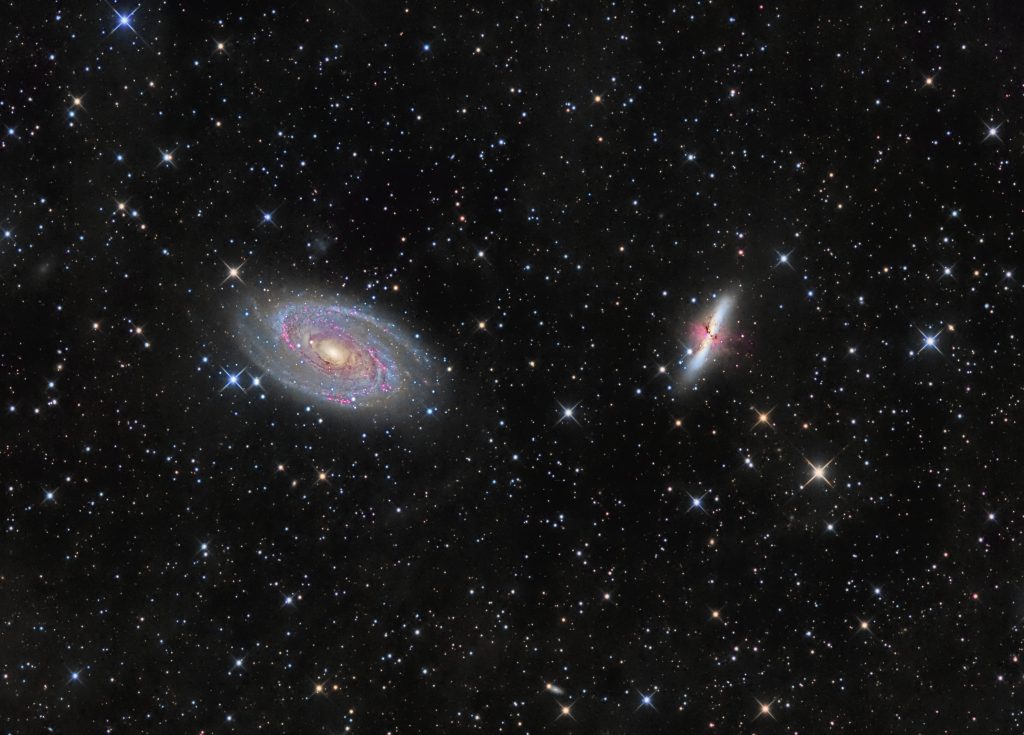
Under dark sky conditions, two impressive galaxies can be seen in binoculars and backyard telescopes by using Alkaid, the bright star that marks the tip of the Big Dipper’s handle. The Pinwheel Galaxy, or Messier 101, is a spectacular and large, face-on spiral galaxy positioned a palm’s width to the left (if facing east) or 5.5 degrees to celestial north of Alkaid, forming an equilateral triangle with Mizar, the double star at the bend of the handle. This relatively close galaxy, only 21 million light-years away, is nearly as large as the full moon in the sky. Since the galaxy’s light is spread over such a large area, its overall brightness is low, however.
Aim your binoculars or telescope several finger widths to the upper right of Alkaid to discover the iconic Whirlpool Galaxy, aka Messier 51. This spiral galaxy’s angular size is smaller, but it will look somewhat brighter in your binoculars and telescope. A secondary galaxy core designated NGC 5195 sitting alongside M51 is linked to the main spiral by a bridge of material (stars and dust).
Let me know how you make out with your galaxy search!
Galaxy Types
Let’s talk about how we use the various shapes the galaxies have to classify them and understand how they came to be.
During early 1920’s at Palomar Observatory in California, astronomer Edwin Hubble was using the recently discovered Cepheid variable star period-luminosity formula to estimate the dimensions of our Milky Way galaxy. Cepheid variable stars vary in brightness with a period of time that is in direct proportion to their true (or intrinsic) brightness. By comparing how bright the star appears with how bright it actually would be if you were a specified distance from it, astronomers could estimate how far away that star is and build up a framework for the shape and size of our galaxy.
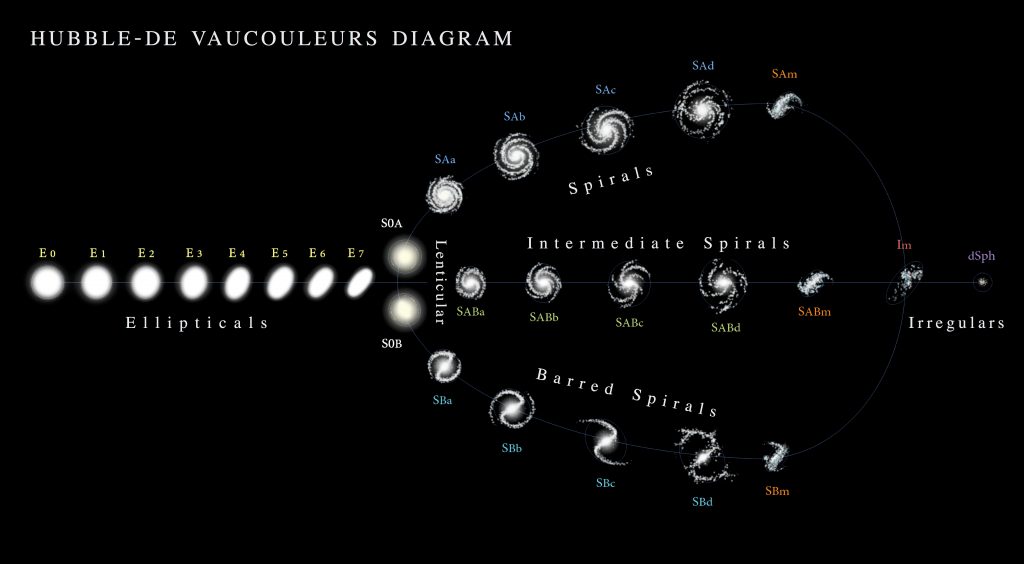
At the time, before large telescopes were available, astronomers did not know that many of the fuzzy patches they were observing in the sky were objects outside of our galaxy; that they were completely other galaxies. They just called them “nebulas”. When Hubble found Cepheids in some of those “nebulas”, such as the one we now call the Andromeda Galaxy (Messier 31), and calculated their distances, he was astonished. Knowing how large our Milky Way galaxy is, he realized that those nebulas must be other galaxies unto themselves!
Starting in 1926, Hubble began to classify galaxies into four styles, based upon the way they look in photographs and through a telescope. He used the terms elliptical (E), lenticular (SO), spiral (S), and irregular (I). Elliptical galaxies are rather dull-looking clumps of stars ranging from round (E0) to highly stretched (E7). But they are now known to be enormous – the product of multiple galaxies merging together and losing their original structures. Each elliptical seems to host a supergiant black hole in the centre. Our Milky Way galaxy and the Andromeda Galaxy will merge in several billion years, probably producing a new elliptical galaxy.
Spiral galaxies have a central core with arms wrapping around it in a flattened disk. The arms can be large or small, and loosely or tightly wound. There can be many arms, or as few as two. The central core can be round or elongated. Needing a way to manage all these differences, Hubble developed the Tuning Fork scheme, where one tine held the round-core spirals (the SA type), sorted by the tightness of their arms. The other tine did the same for galaxies with elongated, or barred, cores (the SO type). He added the letters “a” to “c” to indicate how tightly wound they were.
The ellipticals formed the handle of the fork. Where the fork split, Hubble placed the lenticular galaxies. Those have a central core but no apparent spiral arms, possibly because they have “relaxed” their arms with age – more like a Frisbee than an octopus.
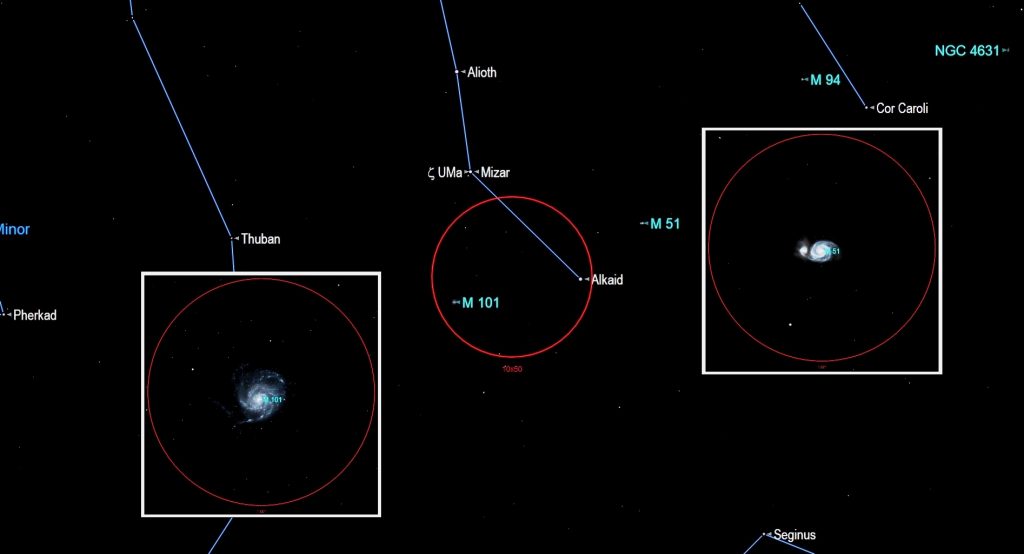
Starting in 1959 French astronomer Gérard de Vaucouleurs and American astronomer Allan Sandage refined Hubble’s system. They added a middle branch for intermediate spirals (SAB type), and lengthened the tines with “d” for very loosely wound, plus “m” for a single arm (i.e., barely a spiral at all). At the far end he placed the leftovers, irregular galaxies. Those are probably gravitationally distorted versions of normal galaxy types.
We classify galaxies based on how they look from Earth, so there’s ambiguity, especially if they are seen edge-on. We can use spectroscopy and images taken at other wavelengths of light to peer inside galaxies and determine their form – even the edge-on ones. The galaxy’s classification codes are often displayed in programs and apps like Stellarium, SkySafari, and Starwalk 2.
Tips for Galaxy Viewing
Here are some tips for finding and viewing galaxies. Start off with a good sky chart or app that shows the prominent stars around your quarry. The book 110 Things to See With a Telescope that I co-authored with John A. Read has easy charts for many dozens of the Messier List galaxies.
Remember – a dark, clear, and transparent sky is the key for success with galaxies! Choose cloud-free, moonless nights (from third quarter to new moon phase each lunar month) and a viewing site away from artificial lights and the city light domes that wash out the night sky. Humid air can dim faint objects, too – as can forest fire smoke and dust. To maximize your eyes’ ability to see faint galaxies, avoiding looking at white light sources for at least half an hour in advance, including car headlights, flashlights, and phone and tablet screens. Dim, red light won’t spoil your dark adaptation. Cover device screens with red film. If you plan to make notes at the eyepiece, use a red headlamp or flashlight. I even cover one white notebook page with dark paper while I write on the opposite page, to reduce the glare. I recently purchased a pair of the red plastic goggles that laser technicians use. They work extremely well for preserving your dark adaptation between looks in the telescope.
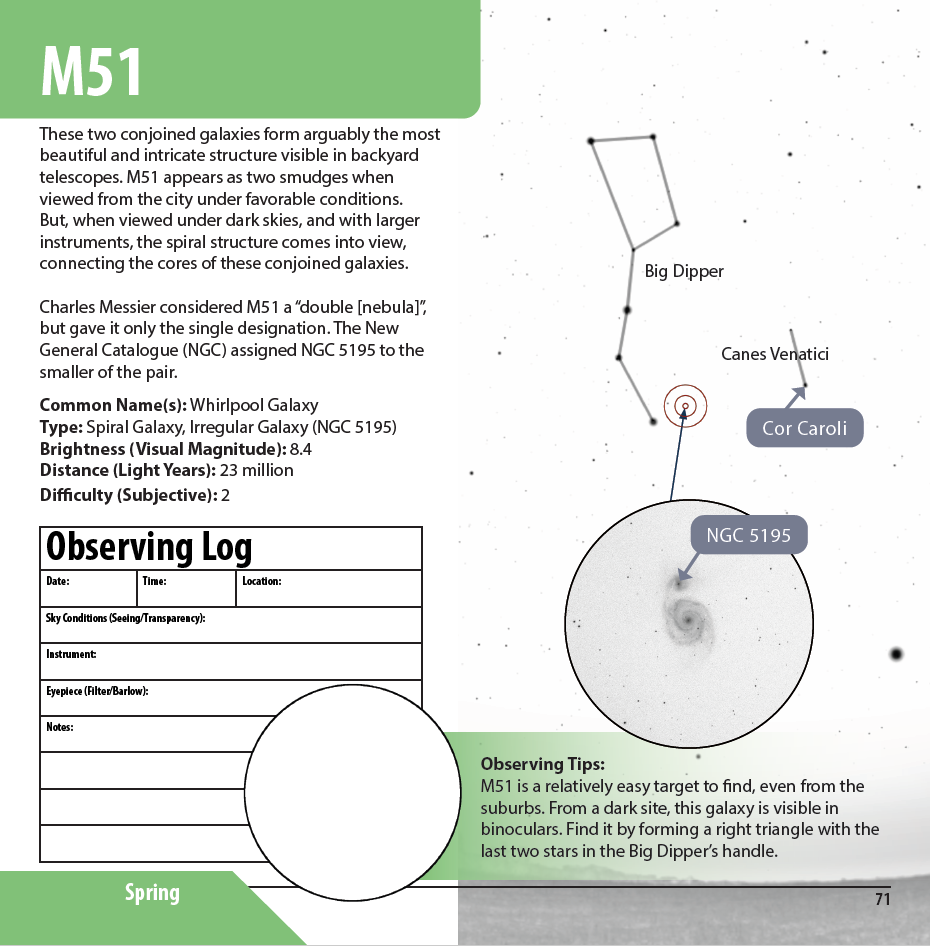
You can also maximize your eyes’ sensitivity by learning to use averted vision when looking through a telescope. The technique involves drawing your attention towards the edge of the eyepiece’s field of view and let your peripheral vision pick up the faint galaxy in the middle. It works because the most sensitive light receptors in your eyes aren’t the central ones. For the best visual acuity, avoid consuming alcohol before observing, try to be comfortably seated, and breathe deeply to oxygenate your eyes.
If you can’t see the galaxy at first, tap the telescope while viewing through it. Faint objects that are in motion will draw your attention better – again by using different eye receptors and brain pathways. If objects seem dimmer than expected, check that you don’t have dew or frost on your lenses and/or mirrors. At home, a hair dryer set to cool and waved across the optics from 30 cm away can clean things up. A 12v blower/fan for camping can work, too. Strapping a chemical hand warmer around the underside of your telescope tube where the lens is can help, in a pinch.
For telescope users, always start searching for galaxies with your lowest power, longest focal length eyepiece. I like a combination that gives me a 1.5° field of view, or three times the moon’s diameter. Once you have the target, note your initial impressions, and then swap in stronger eyepieces to enlarge it. Go easy on zooming in, though. Remember that many galaxies are quite large – a substantial fraction of the moon’s diameter – and you may notice more if they aren’t too spread out under high power!
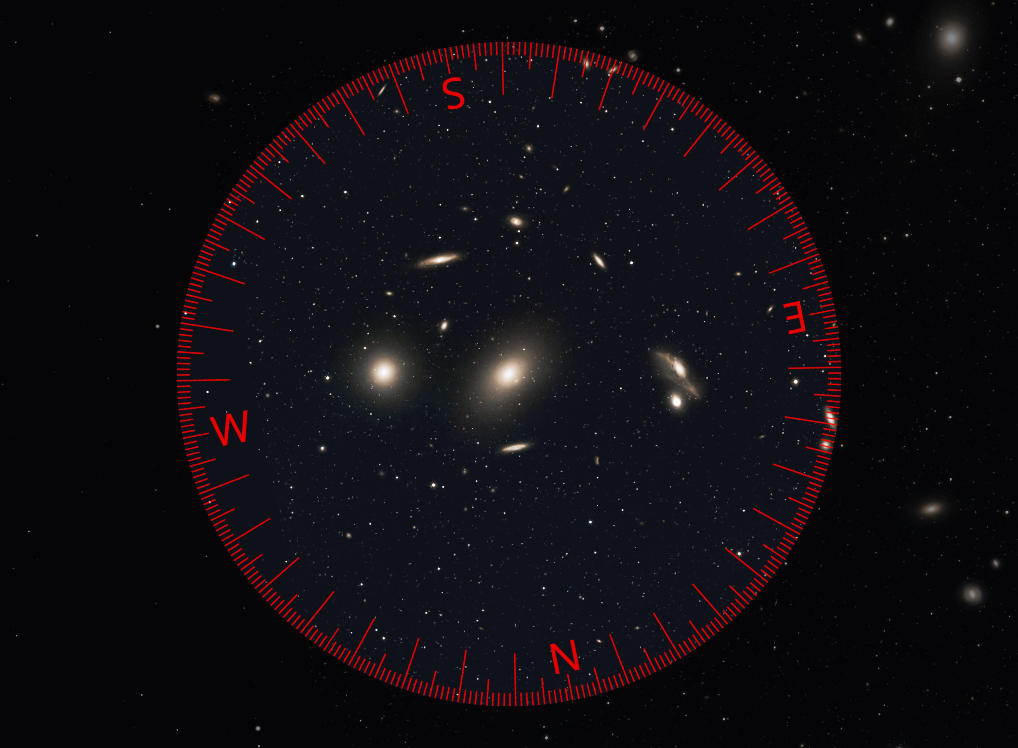
Faint objects are tough to see in small aperture finder scopes. For searching, I recommend adding to or replacing the magnifying finder scope with a Telrad Reflex Sight or another non-magnifying (1X) finder that projects dim red bull’s-eye rings onto a window that you look through while pointing the telescope. Those are terrific because you can always see the brighter stars around the galaxy. Just place those telrad rings on or between nearby bright stars. By the way, it’s a good idea to use stars near your galaxy to focus the telescope before you look for the galaxy itself.

If you are using a star atlas or an app to find your galaxy, remember that the view in the eyepiece will probably be flipped and/or mirror-imaged. Newtonian reflector telescopes (the big cannon-type) rotate the binoculars view by 180 degrees. With them, just turn the book upside down to match the eyepiece view! Refractor telescopes and Schmidt-Cassegrain telescopes (SCT, for short) that use a right-angle mirror to hold the eyepiece will mirror-image the regular scene. It’s helpful to know the expected field of view delivered by your searching eyepiece, too. Some people like to make FOV circles to overlay on paper atlas pages. The better astronomy apps will let you display FOV circles and to flip the display to match your telescope.
If the galaxy you are chasing is not conveniently located near any reference stars, you can start at the best star available and then “star-hop” following recognizable star patterns. Place distinct asterisms at the edge of the FOV opposite to your target. Later, note which stars you hopped to in your observing log. Remember to account for the flipped / mirror-imaged directions.
A Last point – astronomical filters will not help you see or photograph galaxies. Galaxies emit starlight across a broad range of wavelengths, and you want as much of that as you can get!
Public Astronomy-Themed Events
Every Monday evening, York University’s Allan I. Carswell Observatory runs an online star party – broadcasting views from four telescopes/cameras, answering viewer questions, and taking requests! Details are here. They host in-person viewing on the first clear Wednesday night each month. Other Wednesdays they stream views online via the observatory YouTube channel. Details are here.
At 7:30 pm on Wednesday, April 16, the RASC Toronto Centre will livestream their free monthly Speaker’s Night Meeting. The speaker will be Dr. Nadine Manset, Director of Science Operations at The Canada-France-Hawaii Telescope. Her topic will be The Canada-France-Hawaii Telescope: a Journey through Space and Time. Check here for details and watch the presentation at https://www.youtube.com/rasctoronto/live.
Space Station Flyovers
The ISS (or International Space Station) will not be visible gliding silently over the Greater Toronto Area this week.
Keep your eye on the skies! I love getting questions and requests. Send me some!